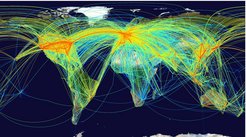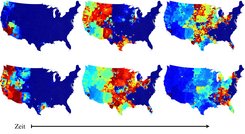Travelling epidemics
Human mobility patterns and their impact on the spread of epidemics
In a globalised world, infectious diseases such as SARS, swine flu or seasonal influenza can be transmitted over the entire planet by travellers. To enable a more effective response to this threat, scientists are trying to predict the propagation pathways and speed of such pandemics. Scientists at the Max Planck Institute for Dynamics and Self-organization (MPIDS) in Göttingen and at University of Göttingen, Northwestern University and Massachusetts Institute of Technology (MIT) in the USA, have now, for the first time, managed to develop mathematical models which account for individual mobility patterns. Not only did new calculations confirm that earlier models had significantly overestimated the speed with which diseases are propagated. The previously known criteria for a global outbreak also had to be broadened. The new study was selected by the American Physical Society for publication in the first issue of its new high-profile journal, Physical Review X.

The most important and, at the same time, most complex unknown in predicting epidemics and their propagation is the human being. The spread of a disease depends entirely on which way an infected individual travels, and where this person meets other people who he or she may infect. For example, if an infected person goes on a long-haul flight, this will give rise to a completely different scenario than if he or she just travels to the next town. “Until now, the human mobility patterns used in the models were rather idealised, because no one knew how to refine them mathematically”, Theo Geisel, Director of the Max Planck Institute for Dynamics and Self-Organisation, explains. “Our model is the first one to be able to describe the individuals of a population and their unique mobility patterns.”
Earlier models bypassed this problem by applying the simplified assumption that an infection spreads according to the principles of diffusion – much like a coloured gas escaping from a container. “However, these models do not take into account that, in a globalised world, both short and very long journeys are possible”, says Dirk Brockmann from Northwestern University. Even more recent attempts to include intercontinental travel did not reflect all aspects of human mobility. Indeed, the members of a population were previously not considered as individuals with unique destinations. Instead, the models simplified matters by assuming that each person will eventually visit every possible location.
New studies, which form the basis of the latest calculations, point to a different pattern, corroborated by collected data. Most people typically only regularly visit a limited number of places outside of their own home, e.g., the workplace, the closest supermarket or the kindergarten. Visits to relatives in another region are more infrequent, and trips to, say, Mexico, are rare. Most people never visit a majority of the destinations. This results in an individual mobility network which consists of the limited number of destinations that the person will travel to.
Scientists are now using these individual, star-shaped networks in their models. The base for each journey is the person’s home. Before returning home, the person will typically only visit one place. “It is precisely this return to the base location that has not been considered in previous models”, says Vitali Belik, a researcher at the Max Planck Institute for Dynamics and Self-organisation and at MIT. The new approach provides a complex system of equations, which the scientists were able to investigate with the aid of intricate mathematics in sophisticated computer simulations.
“Our calculations show that an increasing individual mobility will not – as previously assumed – result in an ever increasing propagation speed of a disease”, Geisel says. In the end, a higher number of trips will not change the fundamental character of the networks. Whether a person makes the journey to the workplace once or twice per day will hardly affect the propagation speed of the epidemic. This is why earlier models significantly overestimated the spread of epidemics.

Recent findings also concerned the criteria which need to be fulfilled in order for an epidemic to hop from one population to another, that is, from one continent to the other. “Previously, it was thought that only the frequency of long trips matters”, Brockmann says. It is now clear that another factor is more significant: the duration of trips. It is not until the average duration of a trip exceeds a certain value that an epidemic may become a global pandemic. “Effectively, what matters is how long you are travelling for, not how often you travel”, the scientists say.
With this scientific article, the American Physical Society (APS) ushers in a new era of open access publishing. The new study was selected by the APS for publication in the first issue of its new open access journal, Physical Review X. In contrast to conventional scientific journals, these journals make scientific work available on line to all readers, free of charge. The work of Belik, Geisel and Brockmann, together with four other articles published in the first issue, will thus be given great exposure, as the scientists have used methods from theoretical physics to gain new fundamental insight into the propagation of diseases.

